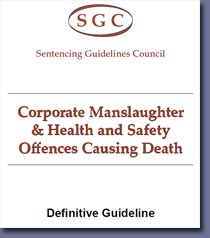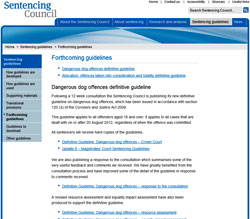 Dave Joyce, CWU's National Health, Safety & Environment Officer gives us an update on the changes to the penalties now awarded for Health and Safety crimes as well as Corporate Manslaughter.
Dave Joyce, CWU's National Health, Safety & Environment Officer gives us an update on the changes to the penalties now awarded for Health and Safety crimes as well as Corporate Manslaughter.
As reported previously, earlier this year new Sentencing Council Guidelines came into effect. As a result, large companies can now face much higher fines for Corporate Manslaughter and Health and Safety Offences at both at the Magistrates and Crown Courts.
The more serious Cases will be dealt with at Crown Court level with fines of over £10 million for the most serious health and safety offences and more than £20 million for corporate manslaughter convictions now possible, under new sentencing guidelines, issued on 1st February 2016. This is an end of year update.
The Sentencing Council’s guidance, which came into force on 1 February 2016 and applies regardless of the date of the offence, give Judges a framework of tiered penalties for different sizes of organisation, taking account of the level of risk, harm and culpability.
The new guidance extends to all health and safety offences, where the previous Judges’ guidance covered just fatalities. It is modelled on the sentencing guideline for environmental offences, which was introduced in 2014.
Once the court has established a starting point using the new guidance factors, it must take into account financial information, such as the profit margin of the organisation or the potential impact on employees, and any aggravating or mitigating factors. The sentencing guidelines contain a total of nine steps that judges must complete to arrive at the fine.
In the past, some offenders did not receive fines that properly reflected the health and safety crimes they committed and the new guidelines are aimed at bringing in appropriate penalties. The guidance wants fines to be proportionate to the seriousness of the offence and the financial means of offenders.
The Guidelines place Convicted Health and Safety Offenders in one of four bands depending on turnover:
- micro (with a turnover of up to £2m)
- small (a turnover of between £2 million and £10 million)
- medium (up to £50 million)
- large (more than £50 million).
 This means the sentences will be far bigger, especially for medium and large employers.
This means the sentences will be far bigger, especially for medium and large employers.
For micro organisations the starting point for a fine after a high culpability corporate manslaughter offence will be around £500,000.
A small organisation convicted of corporate manslaughter may face a fine of £1 million to £2 million.
A medium sized company convicted of a high culpability Corporate Manslaughter Act offence can expect a fine of between £2 million and £7.5 million.
For the large organisations (such as for example Royal Mail Group and British Telecom Group) the fine for a corporate manslaughter conviction with a high level of culpability, serious safety failures and lack of risk controls could result in a £20 million fine upwards.
In June, the Appeal Court threw out an appeal by Thames Water against a £250,000 fine and the Judges said that in future, organisations with a turnover in the hundreds of millions could face fines up to levels equal to 100% of the company’s pre-tax net profit for the year in question, even if this results in fines in excess of £100 million.
The largest fine for a corporate manslaughter conviction under the old sentencing regime was £600,000 for CAV Aerospace in August 2015 but under the new guidelines the fine would have been much higher and certainly several millions of pounds.
Large organisations could also face fines reaching many millions of pounds for serious health and safety at work act offences. For example, the prosecution and conviction of Siemens Windpower under the old sentencing regime resulted in a fine of £375,000 but under the new guidelines the sentence might well have been between £2 million and £6 million.
Likewise, the prosecution of Baxters resulting in a fine of £60,000 for a non-fatal accident might, under the new guidance, increase to a fine between £500,000 and £3 million.
 The sentencing council stated at the launch of the new rules that if there was a quantifiable economic benefit derived from the offence then this amount should be added to the fine. It also suggests that, in some particularly bad cases, putting the offender out of business may also be an acceptable consequence.
The sentencing council stated at the launch of the new rules that if there was a quantifiable economic benefit derived from the offence then this amount should be added to the fine. It also suggests that, in some particularly bad cases, putting the offender out of business may also be an acceptable consequence.
The courts will consider the impact of the fine on employment of staff, service users, customers and the local economy, but not shareholders or directors.
If a company has recent safety convictions then the fine is likely to increase, the guideline says. The list of aggravating factors that would make a fine worse include cost cutting at the expense of safety, a poor health and safety record and targeting vulnerable victims.
Mitigating features that could reduce seriousness include a good health and safety record, a high level of cooperation with the investigation and evidence of steps taken to remedy a problem.
Lawyers are collectively saying that “health and safety managers should tell their Company boards that, “a tougher line is being taken for breaches of health and safety law, not just against companies, but also convicted individuals where the prospect of imprisonment is brought much closer following a fatality”.
The HSE Chief Executive’s Report to the December HSE Board concluded that HSE completed 316 prosecutions between 1 April and 31 October 2016, including a number of prosecutions with individual fines over £1 million, under the new Sentencing Council Guidelines to Courts and Judges. These convictions included the following examples amongst others:
- ConocoPhillips (UK) – Failure to control three Gas Releases over two days endangering the lives of 66 Workers – (£3m)
- Watling Tyres Ltd – fatality following Compressed Air explosion (£1m)
- Foodles UK Ltd – accident on the Star Wars film set (£1.6m)
- Merlin Attractions Operations Ltd – Rollercoaster accident at Alton Towers (£5m)
- Balfour Beatty – collapsed trench (£2.6m)
- Tata Steel UK Ltd – amputation after machinery accident (£1.8m)
- Cristal Pigment UK Ltd – fatality following release of toxic vapour (£1.8m)
- Scottish Power Generation – serious burns after steam release from valve (£1.75m)
- Tarmac Trading Ltd – two road traffic accidents involving pedestrians, including one fatality (£1.3m)
- Parker Hannifin Manufacturing Ltd – fatality when moving machine in the factory (£1m)
- Tesco Stores Ltd – Maintenance Worker fell through skylight(£500k)
- Travis Perkins Ltd – Death of a Customer, crushed by a company vehicle (£2m)
- McCains Frozen Foods - engineer sustained serious arm injury whilst inspecting a factory machine belt (£800,000)
Also note:-
- BT – Three separate Safety convictions in five months in 2016, two falls from height, one street works (£1.3 M)
- Royal Mail – Two Safety convictions in 2015/16, one worker chemical burns, one worker crushed foot by an FLT (£105,000)
Comparison with Competition Fines:
When comparing Health and Safety Fines with Unfair Competition Fines, there’s a long way to go.
For example, Supermarkets and Dairy firms were fined £50million over price rigging on Milk and Cheese by the UK Office of Fair Trading and last year Royal Mail was fined £40m in a French price-fixing scandal by the French competition authorities after GLS, its parcel delivery subsidiary took part in one of the largest price fixing cartels in corporate history, colluding with 20 courier and shipping firms to set customer prices for a period of six years.
However, the new sentencing guidance is beginning to drive up fines towards those well established in competition offences and it’s worth repeating the advice of many UK Lawyers;
health and safety managers should tell their Company boards that, “a tougher line is being taken for breaches of health and safety law, not just against companies, but also convicted individuals where the prospect of imprisonment is brought much closer following a fatality”.
Source: CWU / LTB716/2016
The February 2016 Sentencing Guidelines for health and safety offences and coprorate manslaughter is available from the E-Library. Click the Guidelines cover pic above.


 Dave Joyce, CWU's National Health, Safety & Environment Officer gives us an update on the changes to the penalties now awarded for Health and Safety crimes as well as Corporate Manslaughter.
Dave Joyce, CWU's National Health, Safety & Environment Officer gives us an update on the changes to the penalties now awarded for Health and Safety crimes as well as Corporate Manslaughter. 
